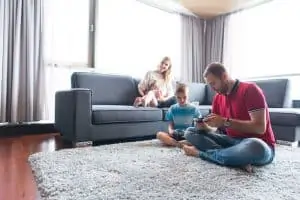Have you ever yelled at your kids before? Go on, be honest. I have too. Yes, I’m a licensed psychologist, but I’m a human being, and on occasion, I do succumb to my inner weaknesses.
In the times that I’ve yelled at my kids, I was not taking care of my needs (lack of sleep and that sort of thing) making me more prone to irritation. And there’s one thing I can’t stand – I hate it when I’m ignored or taken advantage of.
You’d think with my training I’d be able to stay calm all the time, but sometimes we need to let those outbursts out. We should try to avoid expressing them onto our children. But when you do, it’s a teachable moment, something I’ll explain shortly.

The last time I really lost it and began yelling, I’d been asking for over an hour, very politely, for my kids to do their chores. I should mention that I was also asking my husband to pitch in too. This all fell on deaf ears and finally, I just snapped. I began yelling. I felt like our tea kettle that one time when I was in the bathroom and my husband had his earbuds jammed into his ears, loudly singing Chinese songs and oblivious that his hot water was ready.
Feelings are important, they really are. As moms, we’re allowed to get angry. We’re allowed to be sad, happy, irritated, scared, curious, and all those other things. But if we expect our kids to behave accordingly, we’ve got to set a good example. And that example includes not yelling.
But how do I get my kids to listen without yelling?
In the example I provided above, I’d like to point out that no one acknowledged my existence while I was asking politely. But once I yelled and unleashed a fireball of fury, suddenly everyone paid attention.
When we yell though, we are ourselves throwing temper tantrums. We’re old enough and mostly wise enough to find more productive avenues for expressing our anger, right? I thought back to when I was a defiant teenager, and I remembered how I’d tune out yelling too. From my dad and from any adult. It just turned into that “wah wah wah” sound from Charlie Brown.
Yelling might seem like it gets everyone’s attention, but it doesn’t. Even my husband said, “Geez, why are you being such a…” well, I think you know what he finished that with. And I thought to myself, why was I?
Yelling did nothing but upset everyone and raised my blood pressure. I was better than yelling, and you are too. Granted, it’s going to happen from time to time because we’re not perfect. I’m certainly not. Which is why on the occasions I have yelled, I’ve gone off to cool down and then come back to apologize.
Maybe I’m not at my best when I’m yelling, but I want my kids to know that when we make a mistake, we should admit it, apologize for our wrong-doing and move forward.
How to get kids to listen without yelling, screaming, or negativity?
Psychology plays a significant role in how we can manipulate our kids into listening. But before I delve into ways you can get the response you want from your kids without going hoarse or looking deranged, I’m going to go off on just a teensy tangent here.
Recently, I was reading a book called The Bone Seeker: An Edie Kiglatuk Mystery. It has nothing to do with parenting, but if you like mysteries, you’ll find it intriguing. The book is set in the far north of the Arctic and centers around a community of Inuit people.
I’d never read anything about them before outside of little blips I vaguely recall from when I was in school. Why did I think of it now? Because as I was preparing to look for interesting tidbits and facts to give you throughout this article, I found an article by NPR that completely piqued my interest.
The article was about Inuit people and how they never yell at their kids, yet their kids listen to everything they say. They do it through encouraging drama as in acting out a negative scene and trying to resolve it. If you have time, it’s a lengthy read, but it’s utterly riveting.
Psychologists even agree with the Inuit methodology as these dramas are acted out when the child is calm. It allows them to process their feelings and gives them practice at controlling anger. It’s pretty smart because when you think about any time you’re angry, it’s quite challenging to get it under control.
I loved this article and thought this was brilliant. After all, the Inuit people have been doing these things for hundreds of years, passing down their traditions from generation to generation. The art of oral story-telling is a beautiful thing, and it can serve some purpose.
One night, I put it into practice. Instead of the usual dance, I did with my youngest about getting out of the bathtub; I tried out Inuit storytelling instead.
“Ok, it’s time to get out,” I told her.
“Aww noooo! I want to keep playing!” She whined back.
“Ok, sure, but if you stay too long, you’ll turn into a big, ugly fish just like I read about on the news site the other day.”
She was out of that tub like grease-lightning. No yelling required. I’ve tried it since, reminding her that “it’s time to get out of the tub before we turn into a big, ugly fish!” And it keeps working.
More tips on controlling your emotions and leveraging your kids
While the Inuit way is handy, moms all need a bag of tricks to rely on. Sooner or later, my daughter might very decide she doesn’t believe my big fish story and tune me out.
So, how do you stop negative behavior like yelling, screeching, nagging, even hitting so you can get them to yank the potatoes from their ears and listen?
Take care of you
I am so, so, sooooo guilty of this sometimes. We think we have to take care of everyone else, but we forget about the most crucial person…ourselves! It’s not selfish to take time out for self-care. It’s mandatory.
It doesn’t matter if you can’t afford a fancy spa day. Self-care can be making your husband take the kids to the park or out for ice cream while you luxuriate in your tub with a gentle mud mask and a good bottle of wine. It can be taking an art class or just hiding in the garage with a paintbrush and canvas. It can be so many things.
Self-care needs to be something that fills up your cup. Whatever brings you joy and enlightenment, do it. Make time for exercise, eat right, and get your sleep too. All these things add up to keeping you a calm and relaxed person. When you feel like your needs are being met, you are less likely to blow up when you don’t get the response you want from your kids (or your husband).
Find out what sets you off
Another thing you’ve got to do if you want to stop negative behavior is looking at your triggers. What is causing you to blow up? My husband’s chewing is one of them. It can easily send me into a rage. So I turn on music while we eat or even put old Tom & Jerry cartoons on in the background because it drowns out the chomping and slurping, thus keeping me calm.
Breathe deep
Once you notice those triggers, you can start the process of calming yourself and getting a handle on your anger so you can express it appropriately. Inhale deep, then exhale even bigger than that. Your exhaling should be longer than your inhale. This defeats that meddlesome fight or flight response which is triggered by the stress of our kids not listening to us. Center yourself.
While you do, you can tell your kids what you’re doing. This will help them adopt a calmer technique for the times they are angry. Remember, feelings, even anger, are good things! We are all entitled to them, but we all must learn to express them in the right way.
Being proactive about getting kids to listen without yelling
The cycle will go on and on, over and over if you don’t break it now. Kids sometimes just don’t listen. They might not even do it to be disrespectful. Once, my eldest was so engrossed in a book that she didn’t hear me call her for dinner ten times.
Yes, TEN times. Her father even shouted up the stairs like an angry bear. I shot him a nasty side-eye. I put down my fork and went up there to see why she wasn’t listening. When she saw me in the doorway, she jumped with a start. It was then that I realized she didn’t hear us. Being an avid reader myself, I could identify.
I’m glad I didn’t start yelling at her. Instead, I told her it was time for dinner, and she needed to come down now, to which she ultimately complied.
But there are times when kids don’t listen no matter how close they are to you when you’re saying it. And they still will ignore you and test your limits when you ask nicely. So if you want to break the cycle of negative behaviors, you must become a proactive parent.
Set expectations ahead of time
Routines certainly help children because they know what’s expected and how they should behave. If they know they must do their homework as soon as they come home from school before they do anything else, then they will follow through with these things. Setting limits and expectations as a family helps mold this in them and avoids a lot of miscommunication and resulting conflicts.
I’m glad to say that…
My girls are both responsible for keeping their rooms clean. If they pick up after themselves each day, I will always acknowledge how nice their rooms look. Last night though, their places were messy, and I told them that after school, before homework, they must clean their rooms or they can’t watch their favorite shows after their homework is done. As I write this, there is the sound of agreeable cleaning upstairs with both of them helping each other.

I set expectations before we go out somewhere too, for example, a restaurant. My daughters know they can’t be loud or get up from the table. They can color and play quiet games together, but they must be good. I don’t buy them treats at the store every time either, and I will always declare it before we enter. “Sorry, but Easter is coming so I’m not buying any sweets. You’ll get your Easter basket from the Easter Bunny soon.” Teach them some table manners as they grow up.
Also,
Make sure that you’ve clearly outlined what will happen if expectations aren’t met as well. For example, no clean room, no TV shows. No doing chores, no Wi-Fi password. And so on.
Check that they have what they need
Sometimes, our kids don’t feel like listening because they’re tired or hungry, or they’re bored and need to run off that energy. Listen to them yourself. You might find the answer to avoiding your outburst of exasperated yelling lies in taking them for a walk or even just spending time with you.
Sometimes, that’s all they want, and they sit stone-faced until you pull up a chair and say, “Hey! I want to color a princess with you too!” You don’t have to spend hours coloring, but I’ve found getting in on their level diffuses situations that could have turned into obstinance that resulted in yelling.
Put a positive spin
“Don’t touch that!” or “Don’t run!” Or anything with “don’t” in it automatically sets a negative tone. True you don’t want them to touch the hot stove or run down the hall, the key is in altering your request. “Watch out for the hot stove!” or “Please walk” bode so much better. If you start swapping negatives for positives, I’m positive you’re going to get better results.
It takes practice to restrain from yelling. When you do yell, forgive yourself and make sure you calmly apologize to your kids. Then don’t dwell. Show them an excellent example of picking yourself up, dusting yourself off, and getting back into life, and they’ll learn how to handle their emotions too.
Leslie Berry lives with her husband and two young daughters in Los Altos, California, where she loves helping other moms get comfortable with motherhood and embracing the insanity with facts peppered with laughs.
She loves eating too much sushi, exercising, and jamming out on her Fender. Read more about Leslie here.






